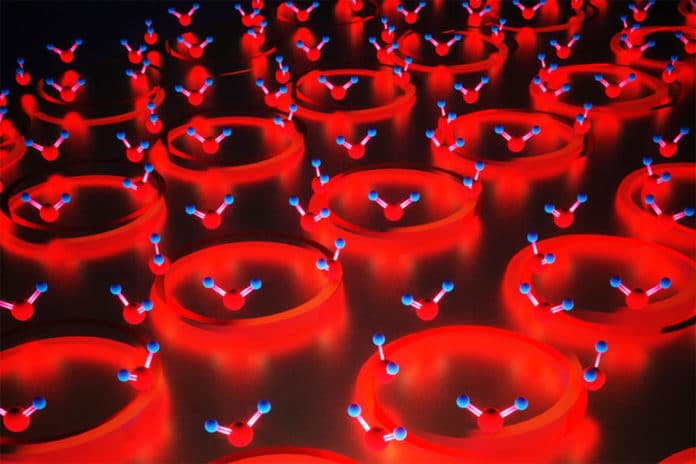Quantum science studies natural phenomena of light and matter at the smallest scales. Recently, scientists made a groundbreaking discovery that offers new insights to develop the next generation of quantum-based optical and electronic devices more efficiently.
Scientists from the University of Minnesota Twin have come up with a unique process to produce a quantum state that is part light and part matter.
Using the process, scientists were able to achieve ultrastrong coupling” between infrared light (photons) and matter (atomic vibrations) by trapping light in tiny, annular holes in a thin layer of gold. These holes were as small as two nanometers, or approximately 25,000 times smaller than the width of a human hair.
These nanocavities, similar to a highly scaled-down version of the coaxial cables used to send electrical signals (like the cable that comes into your TV), were filled with silicon dioxide, which is essentially the same as window glass. Unique fabrication methods, based on techniques developed in the computer-chip industry, make it possible to produce millions of these cavities simultaneously, with all of them simultaneously exhibiting this ultrastrong photon-vibration coupling.
These nanocavities were filled with silicon dioxide, which is essentially the same as window glass. Unique fabrication methods, based on techniques developed in the computer-chip industry, make it possible to produce millions of these cavities simultaneously, with all of them simultaneously exhibiting this ultrastrong photon-vibration coupling.
Sang-Hyun Oh, a University of Minnesota professor of electrical and computer engineering and the senior author of the study, said, “Others have studied strong coupling of light and matter, but with this new process to engineer a nanometer-sized version of coaxial cables, we are pushing the frontiers of ultrastrong coupling, which means we are discovering new quantum states where matter and light can have very different properties and unusual things start to happen. This ultrastrong coupling of light and atomic vibrations opens up all kinds of possibilities for developing new quantum-based devices or modifying chemical reactions.”
The interaction among light and matter is integral to life on earth—it permits plants to convert sunlight into energy, and it permits us to see objects around us. With wavelengths much longer than what we can see with our eyes, infrared light connects with the vibrations of atoms in materials. For instance, when an object is heated, the atoms that make up the object start vibrating faster, emitting more infrared radiation, empowering thermal imaging or night-vision cameras.
Conversely, the wavelengths of infrared radiation absorbed by materials rely upon what sorts of atoms make up the materials and how they are arranged, so physicists can chemists use infrared absorption as a ‘fingerprint’ to recognize different chemicals.
These and different applications can be improved by expanding how firmly infrared light interacts with atomic vibrations in materials. This, thusly, can be accomplished by trapping the light into a small volume that contains the materials. Trapping light can be as straightforward as causing it to reflect to and forth between a pair of mirrors; however, much stronger interactions can be acknowledged whether nanometer-scale metallic structures or ‘nanocavities’ are utilized to limit the light on ultra-small length scales.
When this happens, the interactions can be strong enough that the light’s quantum-mechanical nature and vibrations come into play. Under such conditions, the absorbed energy is transferred back and forth between the light (photons) in the nanocavities and the atomic vibrations (phonons) in the material at a rate fast enough such that the light photon and matter phonon can no longer be distinguished. Under such conditions, these strongly coupled modes result in new quantum-mechanical objects that are part light and part vibration simultaneously, known as polaritons.
The stronger the interaction becomes the stranger, the quantum-mechanical effects that can occur. If the interaction becomes strong enough, it may be possible to create photons out of the vacuum or to make chemical reactions proceed in otherwise impossible ways.
Professor Luis Martin-Moreno at the Instituto de Nanociencia y Materiales de Aragón (INMA) in Spain said, “It is fascinating that, in this coupling regime, a vacuum is not empty. Instead, it contains photons with wavelengths determined by the molecular vibrations. Moreover, these photons are extremely confined and are shared by a minute number of molecules.”
Oh said, “Normally, we think of the vacuum as basically nothing, but it turns out this vacuum fluctuation always exists. This is an important step actually to harness this so-called zero-energy fluctuation to do something useful.”
Journal Reference:
- Yoo, D., de León-Pérez, F., Pelton, M. et al. Ultrastrong plasmon–phonon coupling via epsilon-near-zero nanocavities. Nat. Photonics (2020). DOI: 10.1038/s41566-020-00731-5
